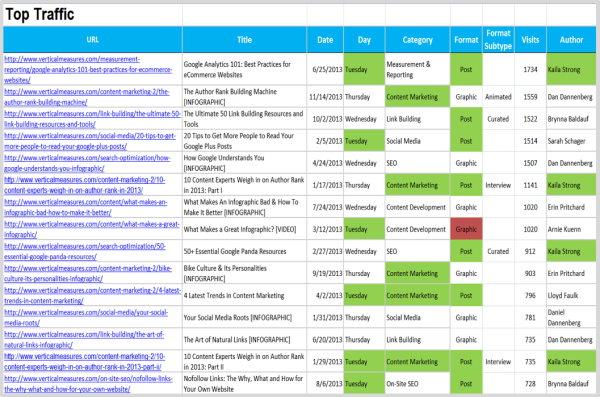
One of the most important tools in content marketing is – without a doubt – the content calendar. It can guide all your content marketing efforts, bring your strategy to life, and help you stay consistent on your way to positive content ROI. While tons of templates and spreadsheets are out there for the calendar itself, what advice is available on how to manage a content calendar?
If you are a marketing manager of any sort, you know calendar management is not a topic for the faint of heart. Managing a content calendar goes way beyond plugging in author names and publication dates. It’s about juggling multiple priorities, coordinating many people’s calendars, and all the while trying to find opportunities for good messaging and lead generation. The best way to think of a content calendar is as a road map, guiding you toward your goals and pointing out the landmarks and potholes along the way … and believe me, it can be a bumpy ride.
Managing a content calendar goes way beyond plugging in author names and publication dates Click To TweetManaging a content calendar sits right in the middle between art and science. With a healthy understanding of how the parts of the spectrum can work together toward a common goal, your content calendar can soar. Let’s take a deep dive into the left- and right-brain elements of managing a content calendar and see if we can more fully understand the importance of this essential tool.
Science
The science of a content calendar is something marketers understand intellectually but don’t always put into practice. It’s been proven again and again that content marketing works for organizations that go all in and follow these principles. They:
- Have a documented strategy
- Follow through with it
- Stay consistent
- Measure, rinse, and repeat
Strategy
Strategy is essential to aligning your people, processes, and priorities around agreed-upon goals. Having a strategy also is an indicator that you are more likely to be successful at content marketing. According to research done by CMI:
- Forty-eight percent of B2B organizations with a documented strategy consider themselves effective at content marketing.
- On the flip side, 77% of the least effective marketers lack clarity on what content marketing success looks like.
What it comes down to is simple:
- Create a strategy.
- Document it.
- Let everyone on your content team know about it.
- Keep on truckin’. (Don’t miss this step or your content calendar will fall flat regardless of what you try.)
Organization
Having a strategy sometimes is worlds apart from implementing the strategy. Get familiar with the hockey-stick effect. You can see this effect clearly in the chart below. This graph of HubSpot benchmark research shows the tipping point for increased inbound traffic, getting an upward jolt after 400 total blog posts. Companies that publish more than this number receive double the amount of traffic than those with 301 to 400 posts. This hockey-stick effect indicates that the more content you publish on your website and your blog, the more benefits you receive – more indexed pages, more traffic, and more leads. What does that equal? More business.

To have more than 400 posts takes some time, serious commitment, and consistency. A content calendar can help keep you honest about your publishing capabilities, and help you (and any of your content creators) stick to a schedule so you can reap the rewards when the time comes.
Tools
Depending on your scale and resources, your content calendar can be as simple as a bulleted list or Excel spreadsheet. Or it can be a more robust system that’s part of a content tool or marketing automation platform. The calendar is your most vital communication tool, so make sure it works for your organization and is easily accessible by anyone who touches your content marketing strategy.
Click to enlarge
Measurement
I had plenty of hunches about what I thought would work for my content marketing strategy over the years. To be honest, a majority of them were wrong. I have learned that intuition is great to jump-start a new tactic, but I must pay attention to the data to see the truth of what works or falls flat. Your content marketing strategy shouldn’t be set in stone. Keep it flexible by auditing your content performance and analyzing patterns and trends to adjust the strategy as necessary.
For example, a simple audit like the example below revealed the more successful days of the week and authors. You also can find additional insights within that raw data to help you continue to refine your strategy and your content calendar.
With the structure around strategy, organization, and tools, as well as the data from measurement, you can ensure your content marketing strategy and implementation is effective by being able to answer questions, such as:
- How do we maintain consistency and quality? The creation of a publishing schedule forces you to be more consistent. Incorporating tools such as a project management system also can help improve the process to ensure both consistency and quality.
- What does the data tell us is working or not? Regular content audits (monthly or quarterly) allow you to review data and create actionable plans to adjust your strategy.
- Are we generating leads and sales? You can evaluate how well your content marketing contributes to the ultimate conversions sought by your organization.
- How are we communicating our plans company-wide? Creating a culture that embraces content marketing within your organization is essential to success. Review your editorial calendar and consider how the content could be more effective with help from your team and others within your organization, whether they assist in content creation or promotion.
- Does our content align with our strategy? With this information, you can assess whether your content reflects the content marketing strategy. If it does, you’re on track. If not, identify if the strategy needs to change or if the content does.
Art
The science of managing a content calendar takes will and determination. The art of managing a content calendar takes tact and, well … artistry. The art of content calendar management has more to do with the subtle things that propel a strategy. It involves curating talented content creators, aligning priorities, and figuring out successful internal processes.
People
People are the lifeblood of your content marketing strategy. Managing a content calendar is really about managing people and doing it with thoughtfulness and sensitivity. These prompt questions can help in improving the content team:
- Who outside of the marketing department can create content?
- What talents do our employees have that might be an asset?
- Who are our subject matter experts that can answer any questions?
- What can we do to incentivize content creation?
- Who can we rely on to submit quality content on time? Who cannot meet deadlines?
- How can we tailor topics for our team based on expertise?
- How can we find opportunities to showcase our team’s talents?
Priorities
Creating and managing a successful editorial content calendar is impossible if content marketing is not an organizational priority. Even if you use external resources, many of your content creators will come from inside your organization and already have full-time responsibilities that don’t involve content. Given that these subject-matter experts live and breathe your business every day, they can provide the best content if they are given the time.
How can you tactfully and sensitively navigate competing timelines and still get what you want out of your content calendar?
First, you need buy-in from the boss, upper management, or whoever calls the shots. Content marketing needs leadership as much as it needs articles and videos. Leaders are the ones who can ignite the content spark and sell the idea of content to everyone. This support helps ensure your team can follow through with the plan detailed in your calendar.
Next, you need understanding. Until your team members truly understand the power of content marketing, how it can work, and how they can play an important role, they won’t make it a priority. Get everyone involved and host content marketing training to get priorities aligned before diving into content assignments and deliverables.
Process
Process sounds like a scientific word, but in this case, it’s a craft to master. Without process, your calendar lacks any means of making an impact on your end goals. Your challenge in successfully managing a content calendar is to sculpt a process that works for your people, aligns with your priorities, and produces measurable results.
Processes can set expectations around:
- Timelines – editing, publishing, promotion, etc.
- Brainstorming strategies
- Communication principles and tools
- Internal and external resources
- Project management systems
- Talent management and training
- Tracking and measurement KPIs
Artistic questions to ask:
- Does our content help solve our audience’s problem? Gauge this by your own gut feelings, but don’t be afraid to ask your audience or your clients if what you are producing is useful to them.
- Do our team members feel their efforts make a difference? Talk with your team and get feedback about their contributions. They will be more invested in contributing to the success of the content marketing strategy.
- Are we being useful and helpful in our content? View your content to make sure it keeps selling to a minimum. Every piece of content should be rooted in this ideal.
- Should we incentivize great content creators? Consider how to reward the most successful contributors, possibly through bonuses or other awards. This can go a long way for boosting morale and the longevity of your content initiatives.
- Did we reveal our personality in our content? Your content should reflect your brand’s reputation, voice, etc. Assess the consistency of your tone and overall vibe. Make sure it reveals the real you, not a fake persona.
- How can we better align our goals with our actions? Take a hard look at your processes to see if they are healthy and sustainable. Identify places where projects get delayed. You may need to delegate or reconfigure some responsibilities.
Culture is key
Managing a content calendar is about much more than timelines and coordination – it’s the most important tool to make your content marketing work and get the results you want to see.
With that said, content marketing will be more successful when you can create a culture where content marketing is integrated and valued. Processes flow easier, people willingly offer ideas, and the content works better with your audience. This takes time, dedication, and patience, but the more you can align your team – your whole team across departments – to adopt a content marketing mindset, the better and quicker the results will be.
Want to take in the art and the science of content marketing? Watch the diverse presentations tackling content marketing success from Content Marketing World 2015 with the video-on-demand pass.
Cover image by Joseph Kalinowski/Content Marketing Institute



